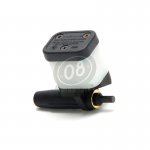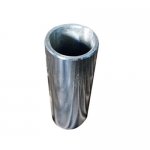Hello,
I have a 1984 BMW R65. The master cylinder is leaking, for the second time since I've owned it. The little steel piston with rubber seals costs over 100USD. I'm loathe to by a second one so soon. I did polish the barrel before replacing this part. The barrel is just cast aluminum and prone, I think, to typical corrosion that limits the life of the sharp lip on the seals.
I've inquired about reboring and have been told that it's as much or more than the new piston/seals (just the rubber seals themselves are not available). It HAS to be a precision bore which must be done professionally. And then a larger ID piston/seal must be used to match the bore.
This is the part,

I wonder if it's possible for me to order an appropriately sized stainless steel precision sleeve, 11mm ID,

...and redrill the cylinders bore to snug fit the OD of the sleeve on my own drill press. This bore is not critical. Insert sleeve with thin film of appropriate brake fluid/glycol resistant adhesive. Now I have a precision 11mm bore in my part. 11mm pistons/seals are readily available for less than 20 dollars. This would seem to be an excellent, and far more reliable, fix.
Any sound objections to this idea?
Thank you all very much.
I have a 1984 BMW R65. The master cylinder is leaking, for the second time since I've owned it. The little steel piston with rubber seals costs over 100USD. I'm loathe to by a second one so soon. I did polish the barrel before replacing this part. The barrel is just cast aluminum and prone, I think, to typical corrosion that limits the life of the sharp lip on the seals.
I've inquired about reboring and have been told that it's as much or more than the new piston/seals (just the rubber seals themselves are not available). It HAS to be a precision bore which must be done professionally. And then a larger ID piston/seal must be used to match the bore.
This is the part,

I wonder if it's possible for me to order an appropriately sized stainless steel precision sleeve, 11mm ID,

...and redrill the cylinders bore to snug fit the OD of the sleeve on my own drill press. This bore is not critical. Insert sleeve with thin film of appropriate brake fluid/glycol resistant adhesive. Now I have a precision 11mm bore in my part. 11mm pistons/seals are readily available for less than 20 dollars. This would seem to be an excellent, and far more reliable, fix.
Any sound objections to this idea?
Thank you all very much.


